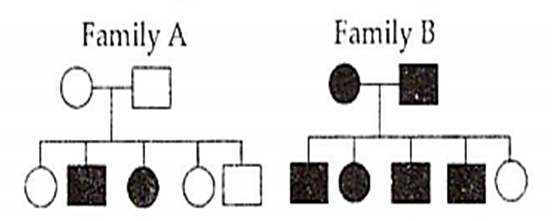 Multiple Choice Questions
Multiple Choice QuestionsIn rabbits, the gene for grey fur (G) is dominant over that for black fur (g). In a litter, if 50% rabbits are grey, then the possible parental cross combination is
GG x Gg
gg X gg
GG x GG
Gg x gg
Barr body is missing in the female suffering from
Huntington's disease
Tay-sach's disease
Klinefelter's syndrome
Turner's syndrome.
D.
Turner's syndrome.
In normal females, number of Barr bodies is one less than the number ofX chromosomes. One Barr body means the female has two X chromosomes. Turner's syndrome (44 + XO) is a genetic disorder that affects only females. In this condition, cells of the affected female possess only one X chromosome, instead of two. Due to the presence of only one X chromosome, no Barr body is present in females suffering from Turner's syndrome
Which is genetically not possible
Haemophilic father transfers the haemophilic gene to his son.
Haemophilic father transfers the haemophilic gene to his daughter.
Carrier mother transfers the haemophilic gene to her son.
Carrier mother transfers the haemophilic gene to her daughter
If 'A' represents the dominant gene and 'a' represents its recessive allele, which of the following would be the most likely result in the first generation offspring when Aa is crossed with aa ?
All will exhibit dominant phenotype
All will exhibit recessive phenotype
Dominant and recessive phenotypes will be 50% each
Dominant phenotype will be 75%
Assertion : Foetal disorders can be diagnosed by chorionic villi sampling.
Reason : Karyotyping can be done for mitotically dividing cells of chorionic villi.
If both assertion and reason are true and reason is the correct explanation of assertion.
If both assertion and reason are true but reason is not the correct explanation of assertion
If assertion is true but reason is false
If both assertion and reason are false
Assertion : Curdling is required in the manufacture of cheese.
Reason : Lactic acid bacteria are used for the purpose.
If both assertion and reason are true and reason is the correct explanation of assertion
If both assertion and reason are true but reason is not the correct explanation of assertion
If assertion is true but reason is false
If both assertion and reason are false
Assertion : Number of chromosomes in one genome is equal to number of linkage groups.
Reason : Linkage groups give important information about the location of genes in the chromosomes.
If both assertion and reason are true and reason is the correct explanation of assertion
If both assertion and reason are true but reason is not the correct explanation of assertion.
If assertion is true but reason is false
If both assertion and reason are false
Which of the following occurs due to monosomy of sex chromosome
Down's syndrome
Turner's syndrome
Haemophilia
Sickle cell anaemia
Which of the following is true for a recessive disease in Family A and B?

In family A, both the parents are homozygous recessive
In family B, both the parents are heterozygous dominant.
In family B, both the parents are heterozygous recessive
In family A, both the parents are heterozygous recessive.
Assertion: In a pedigree analysis, <5> represents five unaffected offsprings.
Reason: In a pedigree analysis, the offsprings are numbered with arabic numerals (1, 2, 3 .....) and a generation is numbered with roman numerals (I, II, III...).
If both assertion and reason are true and reason is the correct explanation of assertion.
If both assertion and reason are true but reason is not the correct explanation of assertion.
If assertion is true but reason is false.
If both assertion and reason are false.
